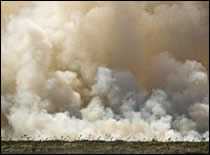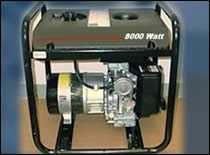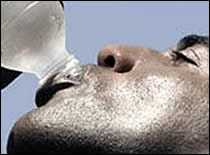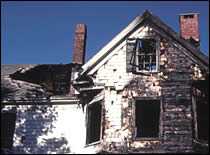Worker Safety During Fire Cleanup
FACT SHEET
Workers face hazards even after fires are extinguished. In addition to a smoldering or new fire, dangers include:
 carbon monoxide poisoning
carbon monoxide poisoning- musculoskeletal hazards
- heavy equipment
- extreme heat and cold
- unstable structures
- hazardous materials
- fire
- confined spaces
- worker fatigue
- respiratory hazards
Workers and volunteers should be advised of and should follow proper safety precautions. Workers’ and volunteers’ experience levels vary, and cleanup crews must work together to ensure safety.
More information can be found at the Emergency Response Resources topic page and at these links:
- Eye Safety Emergency Response and Disaster Recovery
- Suggested Guidance for Supervisors at Disaster Rescue Sites
- Fact Sheet for Workers in Secondary Response and Other Supporting Roles
Electrical Hazards
The four main types of electrical injury are electric shock, burns, falls caused as a result of contact with electrical energy, and electrocution. As power returns after an outage, electrical or traumatic injuries could happen as power lines are reenergized and equipment is turned on. Only trained professionals, such as electricians and utility provider workers, should deal with electrical problems such as downed power lines and restoring electrical power. Other workers should avoid all potential electrical hazards.
 Downed power lines expose workers to electric shock hazards, including:
Downed power lines expose workers to electric shock hazards, including:
- electrical currents that flow through the ground and extend several feet (ground gradient)
- contact with downed power lines that are still energized
- overhead power lines that fall onto and energize materials on the fire ground
- smoke that becomes charged and conducts electrical current
- water on or near energized power lines or equipment
If you are working on or near power lines, the following steps may save your life:
- Never handle a downed power line.
- Assume all power lines are energized and call the power provider to de-energize the line(s).
- Ground power lines on load- and supply-sides of the work area. Grounding protects from feedback electrical energy when a secondary power source, such as a portable generator, is turned on.
- When power is turned on in underground vaults, explosive gases may form. Refer to the Confined Spaces section of this fact sheet.
- Wear appropriate personal protective equipment (PPE), such as Nomex® clothing compliant with NFPA standard 1500, rubber gloves and dielectric overshoes. Use protective tools such as insulated sticks and cable cutters. Click here to view the Personal Protective Equipment resource page.
- Do not stand or work in areas with thick smoke. Smoke obscures electrical lines and equipment. It also can become charged and conduct electrical currents.
If water is or has been near electrical circuits or equipment:
- Never handle a downed power line.
- Turn off power at the main breaker or fuse of the service panel.
- Do not turn power back on until electrical equipment is inspected and qualified.
- Do not use electrical equipment that has been exposed to heat from fire until checked by an electrician.
- Unless power is off, never enter flooded areas or touch electrical equipment if the ground is wet.
If you are working near a downed power line:
- Never handle a downed power line. Only trained professionals, such as electricians and utility provider workers, should deal with electrical problems such as downed power lines and restoring electrical power. Other workers should avoid all potential electrical hazards.
- Contact utility company to discuss de-energizing and grounding or shielding of power lines.
- Use extreme caution when equipment is moved near overhead power lines. For example, contact between metal ladders and overhead power lines causes serious and often fatal injuries.
If you are using gasoline and diesel generators for a building, switch main power breaker or fuse to “off” prior to starting generator. Turning power off protects utility line workers from electrocution and prevents damage from “feedback” electrical energy.
For more information, visit the Electrical Safety Web page.
Carbon Monoxide Poisoning
 Gasoline- or diesel-powered pumps, generators and pressure washers may be used during cleanup. These machines give off carbon monoxide, a deadly, colorless and odorless gas.
Gasoline- or diesel-powered pumps, generators and pressure washers may be used during cleanup. These machines give off carbon monoxide, a deadly, colorless and odorless gas.
Never operate gasoline-powered equipment indoors. It is nearly impossible to tell whether there is enough ventilation or if carbon monoxide is in the air.
For more information about carbon monoxide and gas-powered engines, visit the Carbon Monoxide Hazards from Small Gasoline Powered Engines Web page.
Musculoskeletal Hazards
Cleanup workers are at risk for developing stress, strain, and potential injuries to hands, back, knees and shoulders.
- Avoid back injuries when lifting or moving objects by hand.
- Use teams of two or more to move bulky objects.
- Do not lift material weighing 50 pounds or more (per person).
- Use automated lifting devices for heavier objects.
For more information, visit the Ergonomics and Musculoskeletal Disorders topic page.
Heavy Equipment
- Only properly trained people should operate heavy equipment such as bulldozers, back hoes and tractors. When using heavy equipment, turn power off and block the equipment against motion.
- Use caution around power lines.
For more information, visit:
Extreme Heat and Cold
Heat
Employers and cleanup workers should be aware of workers’ risk for heat stroke, heat exhaustion, heat cramps and fainting. To avoid heat stress, workers should:
 Drink a glass of fluid every 15 to 20 minutes and at least one gallon each day.
Drink a glass of fluid every 15 to 20 minutes and at least one gallon each day. - Avoid alcohol and caffeine. They both dehydrate the body.
- Wear light-colored, loose-fitting clothing.
- Work during cooler hours of the day when possible, or distribute the workload evenly throughout the day.
- When indoors without air conditioning, open windows if outdoor air quality permits and use fans.
- Take frequent cool showers or baths.
- If you feel dizzy, weak, or overheated, go to a cool place. Sit or lie down, drink water, and wash your face with cool water. If you don't feel better soon, get medical help quickly.
Heat stroke is the most serious heat illness. It happens when the body can’t control its own temperature and its temperature rises rapidly. Sweating fails and the body cannot cool down. Body temperature may rise to 106°F or higher within 10 to 15 minutes. Heat stroke can cause death or permanent disability if emergency care is not given.
Warning signs of heat stroke vary but can include:
- Red, hot, and dry skin (no sweating)
- Rapid, strong pulse
- Throbbing headache
- Dizziness, nausea, confusion, or unconsciousness
- An extremely high body temperature (above 103°F)
If you suspect someone has heat stroke, follow these instructions:
- Immediately call for medical attention.
- Get the person to a cooler area.
- Cool the person rapidly by immersing him/her in cool water or a cool shower, or spraying or sponging him/her with cool water. If the humidity is low, wrap the person in a cool, wet sheet and fan him/her vigorously.
- Monitor body temperature and continue cooling efforts until the body temperature drops to 101-102°F.
- Do not give the person alcohol to drink. Get medical assistance as soon as possible.
- If emergency medical personnel do not arrive quickly, call the hospital emergency room for further instructions.
For more information, visit the Working in Hot Environments and Heat Stress web pages. For more information on heat-related illnesses and treatment, see the CDC Web page on Extreme Heat .
Cold
Water cooler than 75ºF (24ºC) removes body heat more rapidly than can be replaced. The result is hypothermia. To avoid hypothermia:
- Wear high rubber boots in water.
- Ensure clothing and boots have adequate insulation.
- Avoid working alone.
- Take frequent breaks out of the water.
- Change into dry clothing when possible.
Unstable Structures
 Never assume that fire-damaged structures, walkways, sidewalks, parking lots and roads are stable. These may have structural damage and can be dangerous.
Never assume that fire-damaged structures, walkways, sidewalks, parking lots and roads are stable. These may have structural damage and can be dangerous.
- Do no work around any fire-damaged structure until it is examined and certified safe for work by a registered engineer or architect.
- Assume all stairs, floors and roofs are unsafe until inspected.
- Leave the structure immediately if it shifts or unusual noises signal a possible collapse.
For more information, visit the Structural Collapse web page.
Hazardous Materials
Tanks, drums, pipes, or equipment that may contain hazardous materials such as pesticides or propane may be damaged.
- Do not move displaced containers without first contacting the local fire department or hazardous materials team.
- Wear appropriate protective clothing and respirators if working in potentially contaminated areas to avoid touching or breathing in vapors. For more information about respirators, visit the Respirators topic page.
- Visit the NIOSH web page for information about proper safety equipment.
- Frequently and thoroughly wash skin that may have been exposed to pesticides and other hazardous chemicals.
For more information, visit:
Fire
Fire can still pose a major threat to an already badly damaged area. Heat sources from smoldering wood or other debris could cause fire again. Contact with something flammable or oxygen can re-ignite materials. Workers must take extra precautions.
At least two fire extinguishers, each with a UL rating of at least 10A, should be provided at every cleanup job.
Working in Confined Spaces
A confined space has one or more of the following features:
- openings for entry or exit are limited
- air flow is limited
- the space is not designed to be occupied by workers for a long period of time
Confined spaces can include these:
- boiler
- furnace
- pipeline
- pit
- pumping station
- septic tank
- sewage digester
- storage tank
- utility vault
- well
- basement
Confined areas may have toxic gases, a lack of oxygen, or explosive conditions. These make them potentially deadly areas.
- Many toxic gases and vapors cannot be seen or smelled. Never trust your senses to decide whether an area is safe.
- Never enter a confined space unless you have been properly trained, even to rescue a fellow worker.
- Contact your local fire department for help if you need to enter a confined space and do not have proper training and equipment.
For more information, visit the Confined Spaces web page.
Worker Fatigue
Stress, long hours, and fatigue may increase the risk of injury and illness. These are often combined with emotional and physical exhaustion, losses from damaged homes and temporary job layoffs.
Workers exposed to stress are at greater risk for injury and emotional crisis and stress-caused illnesses and disease. People working in all phases of cleanup can reduce injury and illness in these ways:
- Accept emotional support from family members, neighbors, and local mental health care workers to help prevent more serious stress-related problems.
- If family and neighbors cannot give emotional support, see a community health or mental health care worker.
- Set priorities for cleanup tasks and pace work over days or weeks to avoid physical exhaustion.
- Rest and take frequent breaks BEFORE exhaustion builds up.
- Begin a normal sleep schedule as quickly as possible.
- Take advantage of disaster relief programs and services in your community.
For more information, visit:
Respiratory Hazards
- Cleanup workers may be exposed to ash, soot and break-down products from burned material that may irritate airways and otherwise affect breathing.
- Spoiled and wet plants and other organic material can grow a lot of bacteria and mold during warm weather. Breathing bacteria and organic dust may cause lung disease.
- Use proper engineering controls to exhaust and replenish enough fresh air when working indoors.
- Use a high efficiency particulate air (HEPA)-type vacuum when cleaning dust. A typical household vacuum can put dust back into the air.
- When exposure to dust cannot be controlled or avoided, use a well-fitted, NIOSH-certified air-purifying respirator (such as an N-95 or more protective respirator) to reduce the effects of dust.
First Aid
First aid, even for minor cuts and burns, is extremely important as workers are exposed to smoke and burned material. If someone is injured, contact a physician to determine the necessary type of treatment.
- Immediately clean all open wounds and cuts with soap and clean water.
- Except for minor scratches, some cuts may need treatment to prevent tetanus.
Protective Equipment
Ensure you have access to these personal protective equipment items:
- hard hats
- goggles or safety glasses
- heavy work gloves
- ear plugs
- boots with steel toes
If working near downed power lines:
- Nomex® clothing compliant with NFPA standard 1500
- rubber gloves
- dielectric overshoes
- use protective tools such as insulated sticks and cable cutters
Noise from these types of equipment may cause ringing in the ears and subsequent hearing damage.
- chain saws
- back hoes
- tractors
- pavement breakers
- blowers
- dryers
When shouting is necessary to be heard over noise, wear earplugs or other hearing protection devices.
For more information, visit:
- Personal Protective Equipment
- Respirators
- Chemical Protective Clothing
- National Personal Protective Technology Laboratory
Your local OSHA office also will have more information.
- Page last reviewed: December 27, 2012
- Page last updated: December 27, 2012
- Content source:


 ShareCompartir
ShareCompartir

